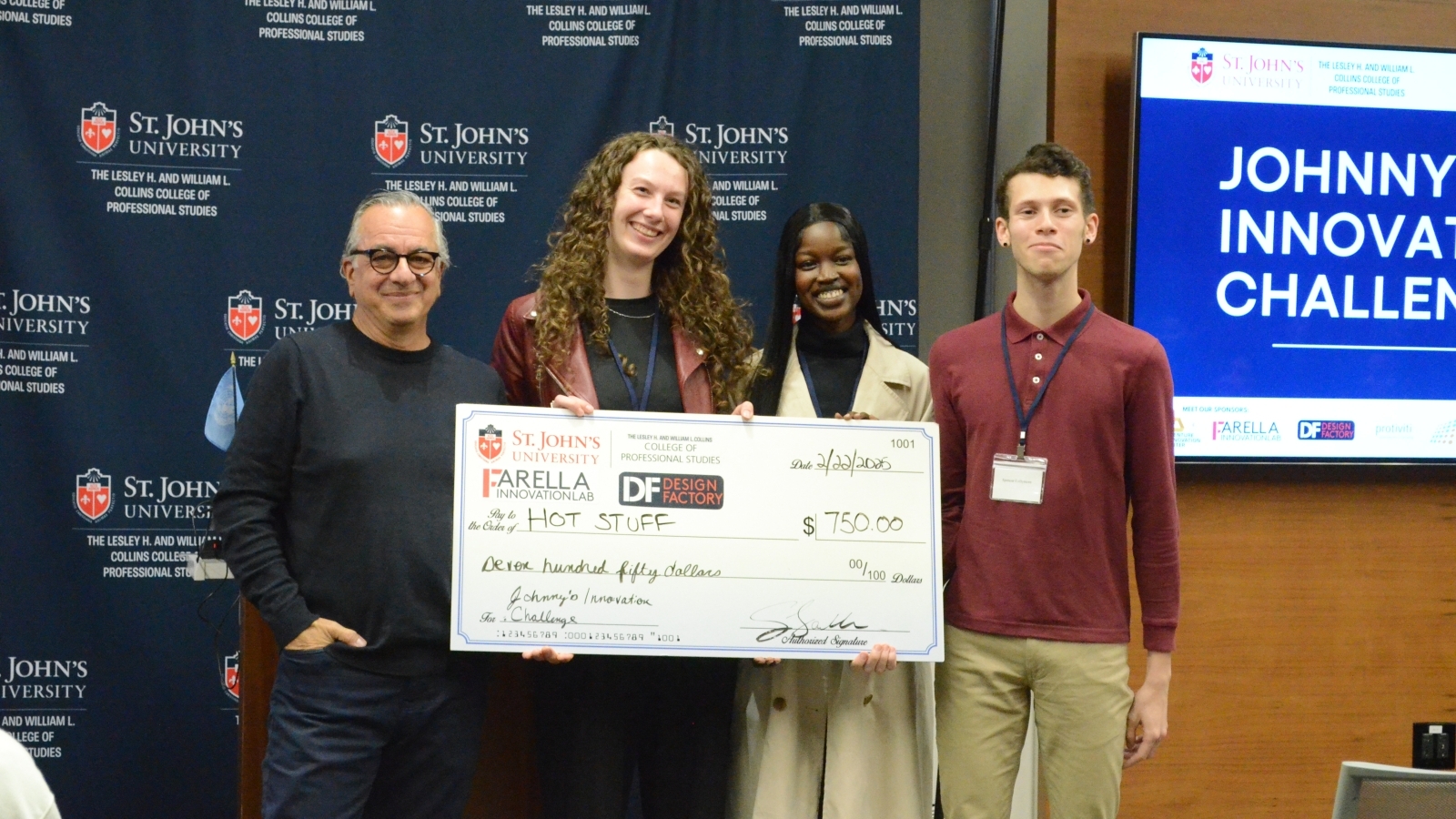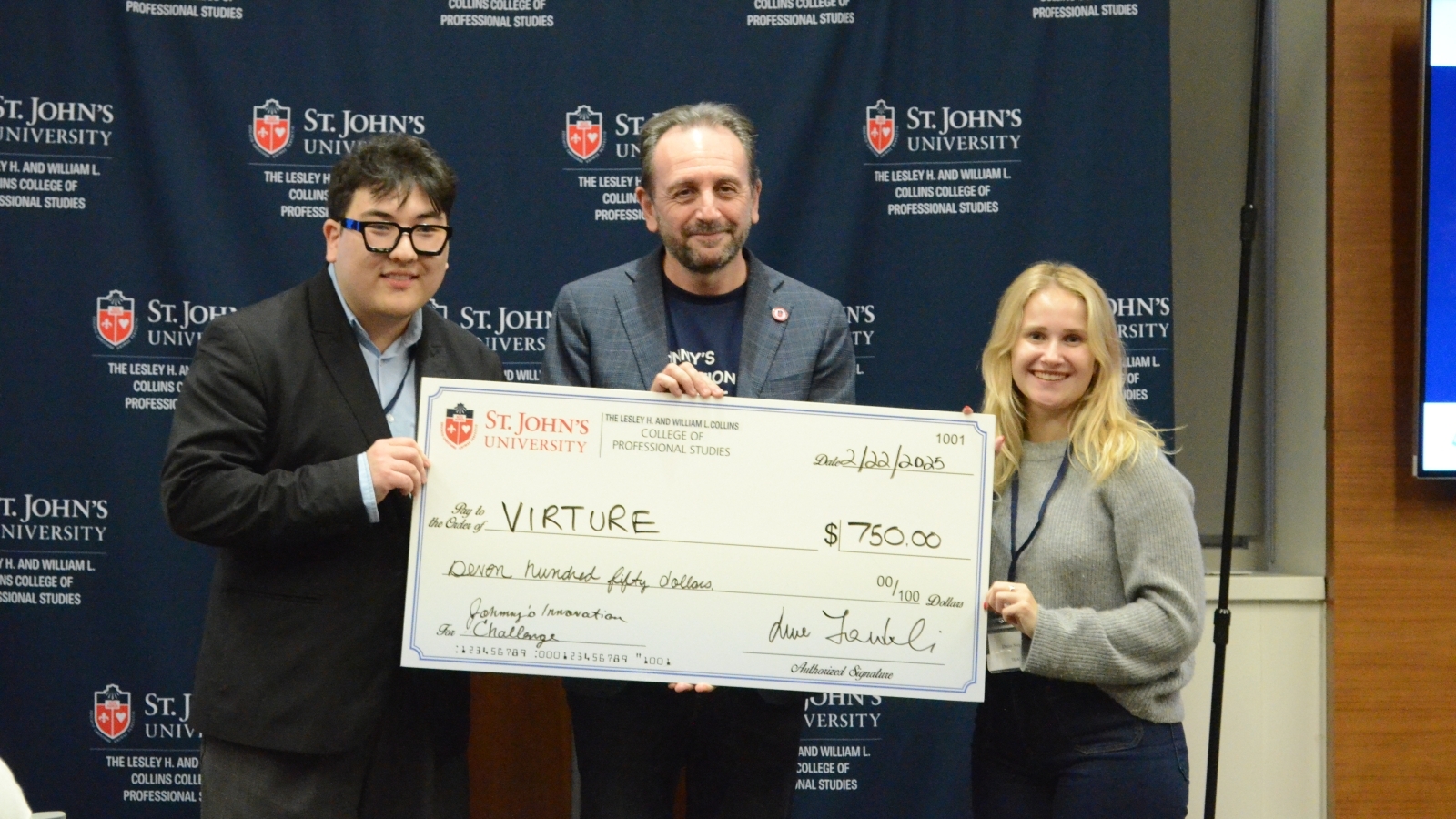How St. John’s Students Turn Big Ideas into Real-World Impact

At St. John’s University, students are empowered with hands-on learning opportunities to build skills, gain valuable mentorship, and turn visionary ideas into action. One standout event is the business pitch competition known as the Johnnies Innovation Challenge.
In this Q&A, we hear from the three winning student teams of the 2025 Johnnies Innovation Challenge. They share the inspiration behind their business ideas, the skills they gained through participating, and how experiences like this are helping shape their futures.
What is Johnny’s Innovation Challenge?
The Johnny’s Innovation Challenge is a student-led pitch competition at St. John’s University that brings together creative minds from all academic disciplines to develop and pitch innovative solutions aligned with the United Nations Sustainable Development Goals (SDGs).
The 2025 challenge offered exciting incentives, including exclusive internships, spots in the Venture & Innovation Center’s (VIC) Incubation Program, and scholarships to attend the European Innovation Academys summer accelerator program in Portugal.
Read the news article for the 2025 Johnny’s Innovation Challenge event recap.
1) Meet Team Hot Stuff: Brewing Change with Mushroom-Based Cups
St. John’s students Cara Dunleavy, Niyadeng Tour, and Spencer Collymore set out to combat plastic waste with their innovative concept, Hot Stuff—biodegradable cups made from mushrooms.
What inspired your business concept, Hot Stuff?
Cara: Fungi has been a passion of mine for a while. My perspective shifted dramatically—from being terrified of them due to personal health experiences, to gaining a deep appreciation after watching Fantastic Fungi, directed by Louie Schwartzberg. That film opened my eyes to the incredible abilities and vital roles fungi play in our lives.
Right now, two billion people lack access to clean waterways due to plastic pollution and waste dumping from other countries, including the United States. That fact stood out to us.
Spencer: We knew we wanted to play to our strengths as environmental science majors. After brainstorming many ideas and deeply researching each one, we set aside information on eco-friendly alternatives and a mushroom leather concept—which eventually evolved into the cup concept.
How did your personal and academic backgrounds shape the project?
Niyadeng: Cara and I took a class on the Sustainable Development Goals from multiple angles. Although we didn’t connect much during the course, it expanded our understanding of environmental problems and potential solutions. One moment that stuck with me was watching a documentary on waste management, which revealed the shocking reality of how little plastic is recycled. That insight reinforced the urgency of Sustainable Development Goal 12—responsible consumption and production—and became a core driver behind our project. It gave us the framework to create a practical and innovative solution: mushroom-based cups.
Spencer: Many of my classes include multiple research projects, which helped me sharpen my information-gathering skills—crucial for this challenge. One of our most significant advantages over other teams was the amount of research we did before the competition. It gave our idea a solid foundation.
What practical career skills or knowledge did you learn?
Cara: We practice presenting in the classroom, but doing it in a real-world competition taught me much more. I had to learn how to prioritize key information, keep the audience engaged, and shift my mindset—this wasn’t just for a grade; it was for our team. I also realized that creativity isn’t limited to artistic spaces. It’s valuable in every environment, even the ones you wouldn’t expect.
Niyadeng: I gained hands-on experience in entrepreneurship and learned how to think strategically while adapting on the fly. I also developed the ability to craft a compelling pitch—and, more importantly, communicate it confidently.
Spencer: The most valuable skills I gained from participating in the challenge were learning how to present information effectively and concisely, as well as how to identify weaknesses in an idea and improve upon them.
Why should college students join a pitch competition?
Cara: This challenge gave us so much—from new friendships and meaningful connections, to discovering new skills we didn’t know we had. Witnessing everyone’s unique ideas and energy around solving some of the world’s most pressing problems was exciting. Seeing students so driven by real solutions gives me hope. I believe our generation is ready to rise to the challenge, fight climate change, and advocate for human rights across the globe.
Niyadeng: I strengthened my team-building skills, grew my network, and applied fundamental business strategies through the business model canvas. It also pushed me to think creatively and act quickly, while learning to execute ideas effectively.
Spencer: From networking to skill-building, I can’t recommend it enough. Every St. John’s student should take part in something like this.
2) Meet Team KnotHashtags: Supporting Artisans Through Technology
St. John’s University students Matthew Siegel, Prasoon Saha, and Uday Kumar developed KnotHashtags, a blockchain-powered platform to help Indian artisans gain fair market access and authenticate their work in today’s crowded digital marketplace.
What inspired your business concept, KnotHashtags?
Uday: KnotHashtags was born from a desire to empower artisans and preserve traditional craftsmanship in a market dominated by mass production. Etsy and Amazon Handmade exist, but they don’t cater specifically to Indian artisans or leverage Geographical Indication (GI) tags for authenticity. This leaves thousands of artisans struggling with visibility, fair pricing, and global market access.
We saw an opportunity to combine technology with an artisan-focused marketplace, offering blockchain-backed authenticity and fair-trade pricing—a competitive edge against Etsy and Amazon.
How did your personal and academic backgrounds shape the project?
Prasoon: Our diverse academic backgrounds played a crucial role in shaping KnotHashtags. My background in finance gave us a strong foundation in financial modeling and pricing strategies. Udays background in Enterprise Risk Management as a current entrepreneur and his experience as a former software engineer at Hitachi helped us build a secure, scalable technology infrastructure and address various operational risks. Matthew’s experience in finance and leadership significantly strengthened our business strategy and market positioning, enabling KnotHashtags to compete effectively with established marketplaces like Etsy and Amazon Handmade.
Combining our experiences and coursework at St. John’s University allowed us to develop a disruptive, innovative platform.
What practical career skills or knowledge did you learn?
Matthew: Johnny’s Innovation Challenge exposed us to the core elements of building a business: ideation, rapid prototyping, and pitching. We learned how to validate a concept through customer discovery, create a viable business model, and communicate our solution under time constraints—skills you can’t fully develop in a classroom.
As importantly, we gained soft skills like teamwork, adaptability, and strategic thinking, while navigating an environment that mirrored real start-up conditions.
Why should college students join a pitch competition?
Uday: It was, without question, one of the most valuable experiences of our college careers. It pushed us beyond theory and into action. We learned how to think like entrepreneurs: solving real problems, managing uncertainty, and iterating fast. It built our confidence, expanded our network, and allowed us to showcase our ideas.
Most importantly, it laid the foundation for our team to win the New York Business Plan Competition (NYBPC) in the Software & Services category, a milestone we would not have reached without the Innovation Challenge as our launchpad.
3) Meet Team Virture: Making Recycling Effortless with Artificial Intelligence (AI)
Alpamys Yechshanov and Daria Stepanova created the concept of Virture, an AI-driven solution designed to streamline recycling processes and spark meaningful environmental change.
What inspired your business concept, Virture?
Alpamys: I was previously recognized as an AstraZeneca Scholar for my work in sustainability, and I launched ZeroTox, a campaign in New York City raising awareness about plastic pollution. Through these experiences, I saw how much confusion exists around proper waste disposal, even among people who care about sustainability. That’s why I wanted to develop a seamless, technology-driven system that eliminates guesswork and makes recycling effortless.
Daria: I saw this as an opportunity to create a scalable and profitable business model, while addressing an urgent environmental challenge. Many businesses and municipalities struggle with recycling inefficiencies, and I recognized Virture’s potential to streamline waste management, reduce costs, and drive measurable sustainability impact. Alpamys had a strong vision for the product, and I helped shape it into a viable business concept with clear revenue streams and a strategy for large-scale adoption.
How did your personal and academic backgrounds shape the project?
Alpamys: My expertise in UX/UI, branding, and product design was key in ensuring Virture’s system is intuitive, user-friendly, and visually engaging. I focused on developing a seamless interface that simplifies waste sorting and makes recycling accessible for all users. Additionally, my experience with ZeroTox and sustainability-focused initiatives helped shape our environmental messaging and position Virture as a tool for real impact, not just convenience.
Daria: With an M.B.A. in entrepreneurship, I brought in the components of business development, market research, and financial strategy. I focused on understanding our target users, identifying the best revenue models, and ensuring our solution is scalable. My coursework and experience helped us develop a strong business case, define our competitive edge, and position Virture as an investable venture rather than just a passion project. Combining our experiences and coursework at St. John’s University allowed us to develop a disruptive, innovative platform.
What practical career skills or knowledge did you learn?
Alpamys: I learned how to take a complex idea and make it easy to understand—especially when discussing tech and design. It also gave me real experience building something from the ground up and ensuring the user experience was at the center of it all.
Daria: I got better at quickly turning feedback into action. I also fine-tuned my pitching skills and learned how to clearly show our idea’s impact and business potential—which is huge if you’re considering launching a venture one day.
Why should college students join a pitch competition?
Alpamys: It gave us a space to test our ideas in the real world—not just as a class project, but as something that could create change. It pushed me creatively and helped me grow as a designer and problem solver.
Daria: We got to build, pitch, get feedback, and keep improving. That kind of hands-on experience is hard to receive in a regular class setting. Plus, it showed us what working on something meaningful under pressure is like.
Launch Your Big Ideas at St. John’s University.
St. John’s University empowers future innovators with dynamic programs in entrepreneurship and innovation. Through hands-on coursework, cutting-edge resources like our Venture & Innovation Center, and real-world experiences such as Johnny’s Innovation Challenge and industry-led workshops, you gain the tools to turn ideas into impact.









